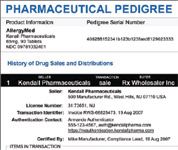Saved by the Delay
Postponement of California's deadline gives the supply chain time to refine ePedigree solutions.
In March 2008, when the California Board of Pharmacy postponed the deadline for compliance with the state's electronic pedigree (ePedigree) law from Jan. 1, 2009 to Jan. 1, 2011, members of the pharmaceutical supply chain breathed a huge sigh of relief. Few firms were prepared to comply.

Hallie Forcinio
One company that could have met the 2009 deadline, privately held wholesale distributor H.D. Smith (Springfield, IL), began exploring pedigree options in 2005. Since then, it has conducted a series of pilot projects with select suppliers, customers, and vendors. "We are fully prepared to handle 100% serialization in Carson, California," reports Rob Kashmer, vice-president of information services at H.D. Smith, referring to the location of one of the company's distribution centers (DC).

TETRA IMAGES/GETTY IMAGES
At the moment, however, pedigree requirements involve extra handling and expense. For example, Florida ePedigree regulations require lot tracking. "This is not a normal process in our DCs, so it adds additional labor and complexity," says Kashmer. To meet Florida's requirements, H.D. Smith confirms each lot as it's received and assigns each lot number a specific location in the DC. This way, order fulfillment can be done by lot number. "There's also additional labor at order-verification stations," he notes, adding, "We do 100% outbound verification at all of our facilities to make sure the invoice and order match perfectly. In Florida, that means packers must look for the lot number on the product. [Currently,] very few are scannable."

SupplyScape software provides ePedigree records that list each stop a drug makes as it moves through the supply chain.
To achieve the item-level serialization that would be necessary to meet California's ePedigree requirements, H.D. Smith has studied radio-frequency identification (RFID) and two-dimensional (2D) barcodes. Unfortunately, a "high percentage of product in the pharmaceutical supply chain has neither," says Kashmer.
In addition, H.D. Smith pilot projects have shown that both technologies currently involve additional labor and expense but don't contribute enough efficiency to the process for full-scale deployment. In fact, Kashmer believes that RFID, which doesn't require the line-of-sight scanning that barcodes do, has an advantage because it can automate receiving and order verification. However, only a small percentage of product currently needs a serialized code. For this reason, tagged and nontagged products must be handled separately; thus RFID also involves extra complexity, handling, and cost.
Nevertheless, technology that has no line-of-sight requirements offers many advantages. For retailers and hospitals, tagged product can not only automate receiving, but also confirm the correctness of prescriptions and locate misplaced product. At the consumer level, a smart medicine cabinet in the home could serve as a compliance aid by tracking when medication is removed from the shelf. The technology could potentially provide an alert when it's time to take a dose or a reminder if a dose is missed.
Of course, the prime reason for pedigree laws is product authentication to ensure that counterfeit product is not introduced to the supply chain. Pedigree information also can help identify cases of diversion.
The new product-authentication process did hit an early snag, though. H.D. Smith could not immediately authenticate the first order of "Viagra" it received with high-frequency 13.56-MHz tags. The order arrived in days, but Pfizer (New York) initially updated pedigree files once a week. Daily pedigree file updates now keep up with the fastest order-to-delivery cycle.
The RFID system at H.D. Smith required participation from numerous suppliers, including providers of hardware (e.g., conveyor portals, antennas, and readers) and software as well as a systems integrator (ePedigree software, SupplyScape, Woburn, MA), and systems-integration services (Franwell, Lakeland, FL). Not only must the components work together, they also must be easy to change. "We've probably changed hardware such as antennas and readers four or five times now as the system [and equipment] continues to evolve," reports Kashmer.
The wholesaler also wanted the system to integrate seamlessly with its warehouse-management system, which works in real time to accept orders and generate advance ship notices, order confirmations, and electronic invoices. As a result, H.D. Smith can send pedigree data to shipment recipients or allow customers to retrieve the data by interrogating its system.
Challenges
As the industry prepares to meet the deferred California ePedigree deadline, numerous challenges remain, including the lack of federal requirements and the proliferation of different state requirements. "A lack of standardization is trouble," says Paul Baboian, senior RFID business-development manager at Zebra Technologies (Vernon Hills, IL), a supplier of RFID tags, printers, and services. Differing requirements mean exception handling, he explains, which reduces efficiency and increases costs.
To complicate matters for global companies, requirements in Europe are not uniform either. However, the European Federation of Pharmaceutical Industries and Associations (Brussels) recommends a unique serial number presented in the form of a 2D data-matrix code on each secondary packaging unit. The federation expects that the industry will eventually switch to RFID when the technology becomes practical and cost effective (1).
Also, consensus about basic questions has not been established. One of the questions is which type of data carrier should be used. Choices include linear and 2D barcodes, RFID, and manual data entry. RFID and 2D barcodes are the current favorites, and most observers predict that RFID will eventually dominate because it can be read without being in the scanner's line of sight. However, it also seems likely that 2D barcodes will continue to be used as a backup for the RFID tags.
Another unanswered question is whether a product's serialized code should include its National Drug Code (NDC), lot number, and expiration date. Including the product-identifying NDC raises privacy concerns and increases the potential for theft. On the other hand, encoding the NDC provides quick identification, potentially saves network traffic, and eliminates the need to refer to a database.
Whether serialization should be performed by the packaging converter or on the packaging line has yet to be determined. With RFID, tagging is more likely to occur on the packaging line, although a few converters currently offer source tagging. One technology under development applies an RFID antenna to an in-mold label during the injection-molding process (RFID in-mold label, Alcan Global Pharmaceutical Packaging, Kirkland, Canada). Barcodes are easily applied at the converting and packaging-line stages.
One drug plant in Ireland laser codes 300 serialized, 2D barcodes per minute on the bottom of plastic vials. The system consists of an ultraviolet laser, material-handling system, integrated vision system to verify code accuracy and traceability, and software to capture data and maintain ePedigree records (material-handling system, FP Developments, Williamstown, NJ; vision system, Cognex, Natick, MA; "ProTrack" software and systems integrator, Crest Solutions, Little Island, Ireland).
Another 2D barcode system integrates a carton-feeding system with an inkjet printer and vision system to apply and inspect serialized codes. The validated portable unit can be moved from line to line (serialized barcode system, Nutec Systems, Lawrenceville, NJ).
Members of the pharmaceutical supply chain also will need to find networks, servers, and computer systems with the necessary bandwidth to accommodate the huge amounts of data associated with item-level serialization. Trading partners will have to find ways to share data. Three standards established by GS1 EPCglobal (Lawrenceville, NJ) should help, including the programmable 96-bit electronic product code number known as the Global Trade Identification Number, the EPCglobal Information Services (which standardizes XML-based data exchange), and the GS1 EPCglobal Pedigree Messaging Standard.
Benefits beyond compliance
The goal of pedigree efforts and laws is to ensure a safe supply chain free from counterfeit product. Some companies only seek compliance. Others view pedigree implementation strategically. Indeed, once product serialization and pedigree record-keeping are in place, previously unavailable supply-chain data can be used in many beneficial ways. For example, one manufacturer increased revenue by halting a parallel trading operation that was diverting product sold overseas into the United States.
Serialization also offers the potential for faster, more precise, and less costly recalls than are currently possible. Recalls tend to be a largely manual process. "You never know if you're done," says Peter Spellman, senior vice-president of products and services at SupplyScape. "A pedigree system can immediately tell you how much of an affected lot was on hand and where it was sent," he explains. "What normally takes days can be accomplished in 15 minutes," he concludes.
Other advantages of serialization include improved inventory management, particularly expiration-date management, expedited payment, and efficient processing of returns.
Although members of the pharmaceutical supply chain can assemble their own systems, some suppliers have collaborated to offer a turnkey solution. Products include the "California Express Solution," which consists of enterprise software from HP (Palo Alto, CA), preserialized packaging from Nosco (Waukegan, IL), ePedigree software from SupplyScape, a packaging-execution system from Systech International (Cranbury, NJ), the "PharmaTrack" serialized distribution solution from Acsis (Marlton, NJ), and serialization strategy and services from VeriSign (Mountain View, CA).
Solutions for electronically capturing pedigree data at various supply-chain points are being brought to the market. One system that supports linear barcodes, 2D barcodes, and RFID tags is available in tabletop, conveyor-mounted, and mobile-cart configurations. The system creates the initial ePedigree; aggregates items into cases, totes, pallets, orders, and shipments; verifies the ePedigree and completeness of incoming goods; updates the pedigree of items being shipped; and provides quarantine or special handling ("Blue Vector Serialization Station," Blue Vector Systems, Palo Alto, CA).
Decisions about suppliers must be made soon to ensure timely delivery and implementation. Waiting 8, 12, or 16 months to place an order could easily double or triple lead times because of order volume.
Although counterfeit prevention is the goal of pedigree requirements, it should be noted that serialization and tracking must be supplemented by physical authentication features because it is "inevitable that serial codes from legitimate product will be copied and used on counterfeit product. The capability to authenticate both the serial code and the physical item quickly, definitively, and in the field will be a critical component of a complete product surety initiative" (2).
Hallie Forcinio is Pharmaceutical Technology's Packaging Forum editor, 4708 Morningside Drive, Cleveland, OH 44109, tel. 216.351.5824, fax 216.351.5684, editorhal@cs.com.
References
1. "Identification and Coding of Pharmaceutical Products in Europe," position paper, European Federation of Pharmaceutical Industries and Associations, Brussels, June 2008.
2. J. Rittenburg, "Authentix Comments to the European Commission, Enterprise and Industry Directorate-General, Pharmaceuticals," European Commission, Brussels, May 7, 2008.
